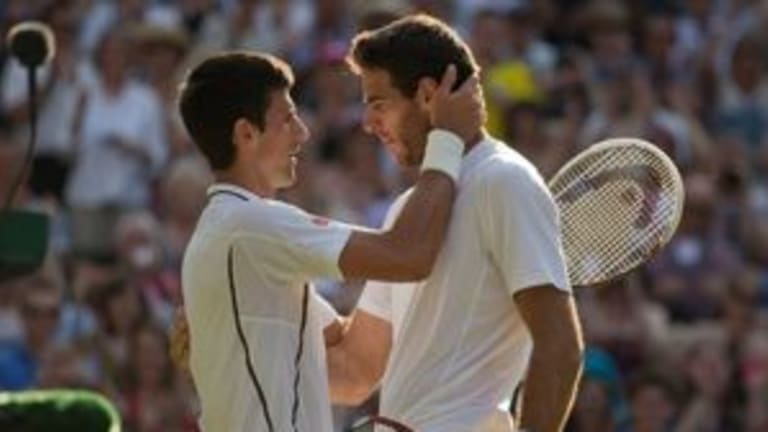—To that point, Wimbledon had been something of a mess—of upsets, injuries, and pratfalls—but Djokovic, the top seed, was squeaky clean through his first five matches. He hadn’t lost a set, and had dispatched the possibly-threatening Tomas Berdych in the quarters with ease. He starts this match the same way, taking almost casual control of the rallies. Djokovic is known as a defender, but he finishes in the forecourt more often than you might think. He came to the net 56 times in this semi, and won 42 of those points.
—Del Potro was coming off after a surprisingly inspired quarterfinal performance. He had taken a scary tumble early in his match with David Ferrer, the man who had beaten him at Wimbledon the previous year, and it looked like the Argentine might never get up. But Delpo did get up...and ran away with the match in straights.
The way he starts this one is more characteristic. As is often the case, his tank-like game needs time maneuver into position before it starts firing. Del Potro fires his first rocket at 4-5 in the first set; sometimes that’s all he needs, one big shot, and he’s awake. By the end of the set he's awake enough to try a tweener. It's the first sign that Delpo is ready to put on a show, as well as play a great match.
—From there, del Potro's inner ham emerges. He’s always been a low-key showman, but he was inspired by this crowd both as a player and a performer. The connection went both ways.
“I really enjoyed watching them as well,” Del Potro said of the Centre Court audience that day. “When I was down in moments of the match, I saw the crowd. They were clapping for me, and that helped me a lot for sure. Was incredible.”
You don’t see it all of his antics in these clips, but Delpo hit a ball at the Hawk-Eye screen in mock-anger; he took a seat at the back of the court after long points; he stared theatrically after missed shots, walked to sideline with his shirt pulled over his head, and ambled over to Djokovic’s side of the net to have a chat about a line call. When Del Potro comically out-grunted Djokovic during one rally, and drew titters from the crowd, it felt like Wimbledon had morphed into The Juan and Nole Show.
—Three thoughts watching these highlights: (1) Yesterday Ilie Nastase said that tennis has become so serious that it's impossible to put on a show. This match proves him wrong. (2) We’ve heard calls for a shot clock in tennis. It would have ruined this day; the sport doesn’t need it. (3) If you make men’s matches two-of-three sets at the Slams, you don’t get the last two here, which were the best of the tournament. You also wouldn’t have witnessed the resilience of both men, which in the end was the biggest highlight of all.
—None of the fun and games would have mattered, though, if the play hadn’t been so superb. Del Potro took huge forehand cuts—one of them was clocked at 120 M.P.H., the fastest at Wimbledon since those records have been kept—that sent Djokovic twisting and turning along the baseline. Crawling, actually; Djokovic spent much of this match on all fours in an attempt to scrape the ball up off the grass. Gumby had turned into Spiderman.
Yet Djokovic hit 80 winners to del Potro’s 48, and he cracked 22 aces. More important, he attacked judiciously. The key points came early in the third-set tiebreaker. The two players had split the first two sets; the winner of the third would have a major advantage. Del Potro went up 2-1 in the breaker, and he had the momentum and the crowd behind him. But Djokovic chose that moment to throw in a rare serve and volley, which surprised del Potro and led to an easy volley winner. On the next point, the Argentine, his momentum suddenly sputtering, put a nervous overhead into the net after a great sliding get by Djokovic. Del Potro wouldn’t win another point in that breaker.
Watching in the press section that day, I felt that the one thing del Potro didn’t show the audience was that he truly believed he was going to win. As much as I loved his performance in this match, if he’s in a similar situation at a Slam in 2014, I’d like to see del Potro not play to the crowd.
